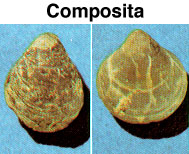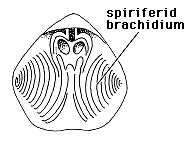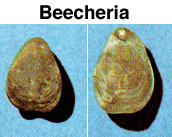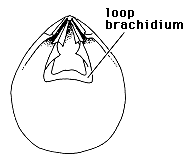



Ancient Life in Kansas Rocks, part 14 of 27
Hustedia, the three small articulate brachiopods at the top left to center, is classed with the spiriferids on internal features (photo approximately natural size). Note the prominent, even, radiating ridges (plications), the pronounced beak containing the pedicle opening on the pedicle valve (side view), and the absence of a fold and sulcus. (Biel Limestone, Upper Pennsylvanian)

Punctospirifer (upper right) and Neospirifer (bottom left and right), are also spiriferids. Punctospirifer is rather small with a distinct fold and sulcus, and the line along which the two valves meet, or commissure, is deeply folded (plicate) especially along the sides. (Biel Limestone, Upper Pennsylvanian)
Neospirifer, on the other hand, is rather large. Note that there is a fold and sulcus, but that the radiating plications, rather than being strong and individually pronounced, vary in size and appear to the bundles containing a principle plication and numerous minor ones. There are also growth lamellae present as concentric bands parallel to the outer margins. (Biel Limestone, Upper Pennsylvanian)
Beecheria and Composita are common brachiopod genera and are shown here to invite comparison and distinction. Illustrative of some of the difficulties encountered in paleontology is the outward similarity of these two very different genera, because these fossils are assigned to different groups on the basis of internal features.


Composita is a spiriferid, with a lophophore-supporting structure (brachidium attached to the brachial valve which resembles two springs coiling outward to the right and left. The lophophore is a feeding organ that sets up water currents which carry food particles toward the mouth of the animal. (Biel Limestone, Upper Pennsylvanian)


Beecheria, assigned to the terebratulids, has a brachidium that is a simple loop. The right view is of the pedicle valve. The left view is of the brachial valve, and shows how the pedicle valve overhangs the brachial valve at the beak. The small circular area in the left view is the pedicle opening. The pedicle, a leathery stalk, protrudes through this opening and adheres to the substrate. Sometimes, weathered specimens may be found that display the aforementioned internal features. (Biel Limestone, Upper Pennsylvanian)
Kansas Geological Survey
Placed online Feb. 1997
URL = "http://www.kgs.ku.edu/Publications/ancient/f14_spirif.html"
Send comments and/or suggestions to webadmin@kgs.ku.edu